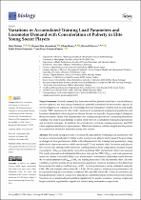Por favor, use este identificador para citar o enlazar este ítem:
https://repositorio.usj.es/handle/123456789/1018
Registro completo de metadatos
| Campo DC | Valor | Lengua/Idioma |
|---|---|---|
| dc.contributor.author | Nobari, Hadi | - |
| dc.contributor.author | Kia shemshaki, Hamed | - |
| dc.contributor.author | Kamiş, Okan | - |
| dc.contributor.author | Oliveira, Rafael | - |
| dc.contributor.author | Prieto González, Pablo | - |
| dc.contributor.author | Mainer Pardos, Elena | - |
| dc.date.accessioned | 2023-11-28T10:03:12Z | - |
| dc.date.available | 2023-11-28T10:03:12Z | - |
| dc.date.issued | 2022-10-30 | - |
| dc.identifier.citation | Nobari, H.; shemshaki, H.K.; Kamiş, O.; Oliveira, R.; González, P.P.; Mainer-Pardos, E. Variations in Accumulated-Training Load Parameters and Locomotor Demand with Consideration of Puberty in Elite Young Soccer Players. Biology 2022, 11, 1594. https://doi.org/10.3390/biology11111594 | en_US |
| dc.identifier.issn | 2079-7737 | en_US |
| dc.identifier.uri | https://repositorio.usj.es/handle/123456789/1018 | - |
| dc.description | Scientific research has demonstrated that puberty status has a crucial influence on soccer players, and their energy demands are primarily determined by their aerobic capacity. In our investigation, we examined the relationships between maturation variables such as peak height velocity (PHV) and maturity offset with variations in accumulated-training load parameters and locomotor demands in elite young soccer players; the aim was to predict the percentage of changes in their performance ability with adjustments to the training load parameters considering maturation variables. Our study’s main findings revealed a link between accumulated-training load parameters and locomotor demands. In addition, the acute:chronic workload, training monotony, and PHV values explained aerobic power performance. This study offers new valuable insights into the practice of accumulation and motor demand in young elite players | en_US |
| dc.description.abstract | The study’s purposes were to examine the associations of training load parameters with locomotor demand and puberty status in elite young soccer players and to predict the percentage of changes in their performance ability with adjustments to the training load parameters, using multivariate regression analysis, while considering PHV and maturity offset. Seventeen male players (15–16 years old) participated in this study. Anthropometrics, body composition, maximal oxygen consumption (VO2max), and puberty status (for calculating PHV) and maturity offset were assessed. The results demonstrated substantial differences between the PHV, VO2max, and load parameters (acute and chronic workload (CWL)) over a soccer season. A substantial relationship existed between the workload parameters (VO2max, CWL, and training monotony (TM)) and maturity offset. All of the variables, except for training strain, demonstrated significant variances in relation to the differences between the first and second halves (p < 0.05). Aerobic performance can be estimated using the CWL, TM, and maturity offset values (R2 = 0.46). On the contrary, aerobic power performance can be explained using the acute:chronic workload, TM, and PHV values (R2 = 0.40). In conclusion, the biological maturity state of young soccer players has a substantial impact on their functional potential. Variations in accumulated load contribute significantly to aerobic resistance, whereas weight and height contribute significantly to sprint and vertical-jump performance, respectively. | en_US |
| dc.format.extent | 13 | en_US |
| dc.format.mimetype | application/pdf | en_US |
| dc.language.iso | eng | en_US |
| dc.publisher | MDPI | en_US |
| dc.relation.requires | Adobe pdf | en_US |
| dc.rights | Attribution-NonCommercial-NoDerivatives 4.0 Internacional | * |
| dc.rights.uri | http://creativecommons.org/licenses/by-nc-nd/4.0/ | * |
| dc.subject | Aerobic power | en_US |
| dc.subject | Training strain | en_US |
| dc.subject | Training monotony | en_US |
| dc.subject | Football | en_US |
| dc.subject | Maturation | en_US |
| dc.subject | Youth | en_US |
| dc.title | Variations in Accumulated-Training Load Parameters and Locomotor Demand with Consideration of Puberty in Elite Young Soccer Players | en_US |
| dc.type | info:eu-repo/semantics/article | en_US |
| dc.relation.publisherversion | https://www.mdpi.com/2079-7737/11/11/1594 | en_US |
| dc.identifier.publicationfirstpage | 1 | en_US |
| dc.identifier.publicationlastpage | 13 | en_US |
| dc.identifier.doi | 10.3390/biology11111594 | en_US |
| dc.rights.accessrights | info:eu-repo/semantics/openAccess | en_US |
| Aparece en las colecciones: | Artículos de revistas | |
Ficheros en este ítem:
| Fichero | Descripción | Tamaño | Formato | |
|---|---|---|---|---|
| Variations in Accumulated-Training Load Parameters and Locomotor Demand with Consideration of Puberty in Elite Young Soccer Players.pdf | 722,5 kB | Adobe PDF |  Visualizar/Abrir |
Este ítem está sujeto a una licencia Creative Commons Licencia Creative Commons

